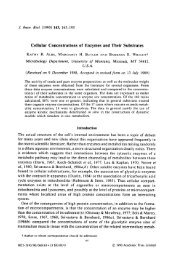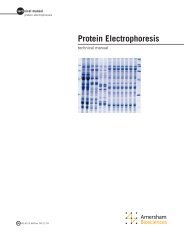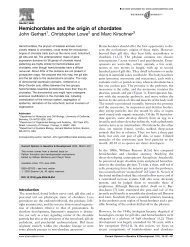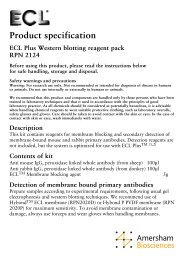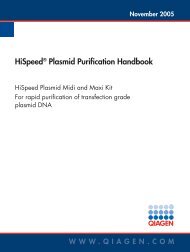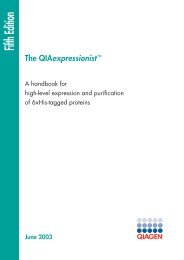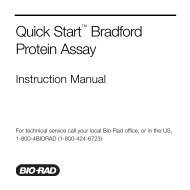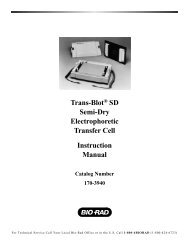Invitrogen Bac to Bac Expression System
Invitrogen Bac to Bac Expression System
Invitrogen Bac to Bac Expression System
Create successful ePaper yourself
Turn your PDF publications into a flip-book with our unique Google optimized e-Paper software.
Isolating Recombinant <strong>Bac</strong>mid DNA<br />
Introduction<br />
After you have transformed your pFast<strong>Bac</strong> construct in<strong>to</strong> DH10<strong>Bac</strong> E. coli and<br />
performed the transposition reaction, use the procedure below <strong>to</strong> purify<br />
recombinant bacmid DNA from DH10<strong>Bac</strong> transformants. Purified bacmid DNA<br />
is suitable for use in PCR analysis or transfection.<br />
Materials Needed<br />
Have the following materials on hand before beginning.<br />
• LB medium containing 50 µg/ml kanamycin, 7 µg/ml gentamicin, and<br />
10 µg/ml tetracycline<br />
• Solution I (15 mM Tris-HCl, pH 8.0, 10 mM EDTA, 100 µg/ml RNase A;<br />
filter-sterilize and s<strong>to</strong>re at +4°C)<br />
• Solution II (0.2 N NaOH, 1% SDS; filter-sterilize)<br />
• 3 M potassium acetate, pH 5.5 (au<strong>to</strong>clave and s<strong>to</strong>re at +4°C)<br />
• Isopropanol<br />
• 70% ethanol<br />
• 1X TE Buffer, pH 8.0<br />
DNA Isolation<br />
Procedure<br />
1. Using a sterile <strong>to</strong>othpick, inoculate a single, isolated bacterial colony in 2 ml of<br />
LB medium containing 50 µg/ml kanamycin, 7 µg/ml gentamicin, and<br />
10 µg/ml tetracycline.<br />
2. Grow culture in a 37°C shaking incuba<strong>to</strong>r until cells reach stationary phase.<br />
3. Transfer 1.5 ml of bacterial culture <strong>to</strong> a 1.5 ml microcentrifuge tube and<br />
centrifuge at 14,000 x g for 1 minute <strong>to</strong> pellet cells.<br />
4. Remove the supernatant by vacuum aspiration and resuspend the cell pellet<br />
in 0.3 ml of Solution I. Gently vortex or pipet up and down <strong>to</strong> resuspend.<br />
5. Add 0.3 ml of Solution II and gently mix. Incubate at room temperature for<br />
5 minutes. Note: The appearance of the suspension should change from<br />
turbid <strong>to</strong> almost translucent.<br />
6. Slowly add 0.3 ml of 3 M potassium acetate, pH 5.5, mixing gently during<br />
addition. A thick white precipitate of protein and E. coli genomic DNA will<br />
form. Place the sample on ice for 5 <strong>to</strong> 10 minutes.<br />
7. Centrifuge for 10 minutes at 14,000 x g.<br />
8. Gently transfer the supernatant <strong>to</strong> a microcentrifuge tube containing 0.8 ml of<br />
isopropanol. Do not transfer any white precipitate. Invert the tube a few times<br />
<strong>to</strong> mix and place on ice for 5 <strong>to</strong> 10 minutes. Proceed directly <strong>to</strong> Step 9 or s<strong>to</strong>re<br />
sample at -20°C overnight.<br />
9. Centrifuge the sample for 15 minutes at 14,000 x g at room temperature.<br />
10. Carefully remove the supernatant, taking care not <strong>to</strong> disturb the pellet. Add<br />
0.5 ml of 70% ethanol. Invert the tube several times <strong>to</strong> wash the pellet.<br />
11. Centrifuge for 5 minutes at 14,000 x g at room temperature. Repeat Steps 10<br />
and 11, if desired.<br />
continued on next page<br />
51



